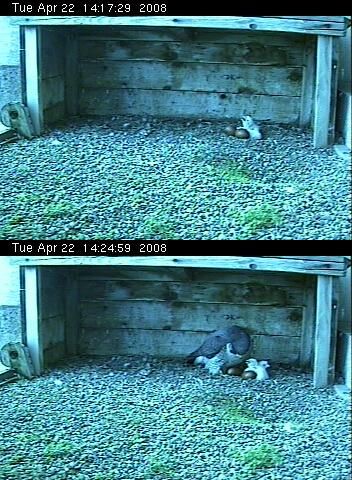 Pictures are worth a thousand words.
Pictures are worth a thousand words.
Here are two snapshots from the Gulf Tower peregrine nest on Tuesday afternoon April 22, thanks to Jamie Sehrer and Joanna Steward.
In the first you can see the two chicks who hatched on April 20 and two eggs still waiting to hatch. The baby birds are so tiny and weak they can barely hold their heads above the eggs. In the second picture, Tasha arrives to feed them.
The chicks cannot regulate their body temperature yet so Tasha will brood them for about 7-8 days. A brooding mother bird looks a lot like she’s incubating. The purpose is the same – to keep the babies warm.
Thanks, Kate. I’d been hoping to see a baby, but every time I went to the site, all you could see was the mother, still brooding her eggs & chicks. They’re so cute. It’ll be neat when the one hatch at the Cath. of Learning site, with its streaming video. then we can really see them. Libby
wow being waiting for the eggs to hatch great job to all for info and pictures. thanks kate to you big time got eveyone at work in on this
I can’t wait to see the last 2 egg hatch. It will be great to see these little guys grow up!
What a thrill. Thanks a million. Barb Simon
Marvelous stuff. But, where is the male parent? Do any fotos show him bringing any food?
John A. Burke
Pictures of the male peregrine: The camera at Gulf Tower site is old and does not do motion detection so we have to rely on viewers like you to capture snapshots. (Right-click on the image and choose Save As.) That leaves it up for grabs as to which bird we see and how many snapshots we get. We may have some snapshots of him and not realize it.
Also, individual birds handle their family life differently. The new male at Pitt is very involved in incubation whereas the male at Gulf is not. However, the Gulf Tower male probably perches nearby. He might even be perched on the camera.

Are the other two eggs in trouble? It has been several days since the first two hatched.
Peregrine eggs normally hatch within a day or two of each other. The fact that the remaining two eggs have not hatched means they probably won’t.
I haven’t been able to see them when Tasha is not covering them, so I am assuming there are still two unhatched. In a few days Tasha will give up on them and move them away from the chicks.
So glad I found your blog…am compelled to watch these birds every day, several times a day, and was becoming concerned because I never see them feeding the chicks! I did observe Tasha 2 carrying away a dead chick in her beak several days ago. Anyone else see that? And I also saw the “incubation switch ” with Dorothy and Erie. That was a bit confusing, as I hadn’t known that they shared that duty. Thanks for all this new info!
Actually you probably saw Tasha take away an egg shell – at least I hope so. The inside of the shell is white and is confusing on camera when the chicks are so small and white too.
So sorry…it was clearly a big chick. I saw a definite head, eye, beak wings, etc. She held it by the nape of the neck and was “caught” by the camera half-way between the other chick/eggs and the edge of the platform. It’s head was twisted to her left and it looked dead (limp, bedraggled, not as plumped up as the other chick I see). I was amazed that I had been able to catch this at the right moment that this occurred. Are there any permanent recordings of that webcam that can be accessed?
I don’t think there are any permanent records from the Gulf camera. The best way to know how many chicks there are is to see them. We’ll just have to wait and see.
Meanwhile, there’s good news in this: Tasha moved the chicks from the scrape they were originally born in (on the right) to the one on the left where she is today. Perhaps you saw her transporting a chick to the new location.
JoAnne, I have a shot from the webcam yesterday that shows one chick clearly, and another white object just behind Tasha2 that I think is too large to be an empty shell, plus the two unhatched eggs. I’m hoping you did catch her in the process of moving her little ones.
Wow! That really is good news! Who knew they moved them like mother cats do? Perhaps, just like kittens do, baby birds become limp when held by the nape of the neck. I think it was a lucky moment to have logged on (is this the right terminology?) to have caught this activity! Thanks for the info.
Wait a minute—after thinking about what you said about Tasha2 moving the chicks, that seemed like a logical explanation, and especially when Amy reported what she has seen about the two eggs and one definite chick and another (possible) chick just behind Tashe2. However, if what I saw was her moving the chicks, how did the eggs show up in the new site? Have I misunderstood the sequence of events, or something?
I’m confused. Perhaps we just have to wait, as you said, until we can visually confirm the number of viable chicks.
As of this morning, both chicks are definitely still there – and wow, have they grown in 5 days!
Whoa! Good shot, Amy F.